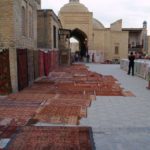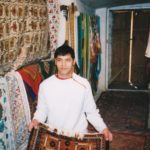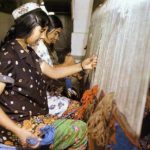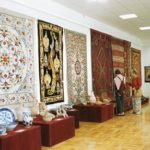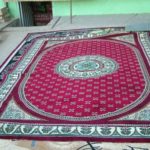Production of carpets in our days takes three different directions depending on who manufactures them. They are: state organizations; private enterprises and homemade. Homemade products of carpeting takes place in Nurata and Fergana valleys; in such regions as Surkhandarya, Syrdarya and Kashkadarya regions; autonomous republic of Karakalpakstan.There are also some workshops in cities: Kokand, Samarkand, Khorezm and Urgut. Masters in these workshops sell their products right from their workshops. Masters of the above mentioned places manufacture variety of carpeting products. To save traditions of this craft, state association named “Usto” and republican industrial center of applied and ancient art called “Musavvir”, conduct a research. These two organizations are trying to find out more information on ancient technologies of carpet production and be able to restore ancient carpet items.
One of the most famous cities for carpet production is considered to be Khiva. Carpets of the factory in Khiva are included in every collection at this time. Khiva carpets are known for its great quality and outstanding designs. The factory constantly introduces new products and recently it launched production of carpets with portraits. Portrait carpets were popular since middle ages, but were not widespread during our time. There are also a lot of private enterprises that play significant role in revival of carpeting. Private enterprises produce high quality items made of natural materials such as cotton, silk and wool. They also use natural dyes to color fabric. Some small carpet producers are located in the rural areas. This gives them advantage of being in proximity to the main source of major materials. Location in rural areas does not only benefit producers by decreased costs, but also benefits local population of these areas. Production employs women, who start to learn weaving and earn money. For the production they use as patterns works of classical Turkmen and Uzbek carpets.
The goal of carpet producers is to restore traditional drawings. At the same time their task to offer high quality items by employing traditional dying methods to color natural fabric. Aniline dyes that were used for a long time do not satisfy quality standards and result in bad carpet aestetic appearance. Government is concerned with prosperity of carpet production and always tries to encourage production by zero taxation and organization of free trainings.
Uzbekistan silk
Silk weaving
“Marghilankhan-atlas” together with “Yodgorlik” play significant role in silk weaving revival. These two companies worked on and achieved their goal of traditional fabrics restoration.Now, manufacturing of such fabrics as khon-atlas, atlas, adras, bakhmal and shokhi-bekasam began again. Classical patterns are now revived and the companies are working on the restoration of natural dyes.
Silk carpets
With the establishment of “Afghan-Bukhara-Samarkand” joint venture, manufacture of silk carpets began its new era in Samarkand. The goal of the company is the revival of silk carpeting in Uzbekistan. For its production the company uses only natural dyes of local origin. As a result, their products look unique. Their items are woven horizontally and vertically. The standard size is 1,5×3 meters. Per square meter has up to 1.2 million knots. The nap length is maximum 2 millimeters. Carpets produced with according to this technology are very thin but are very durable. Such carpets have great quality. In addition to the quality, these carpets have distinctive decoration. They are valued mainly for their outstanding decoration rather than for their quality. Production of silk carpets is developing not only in Samarkand, but also in Bukhara.









